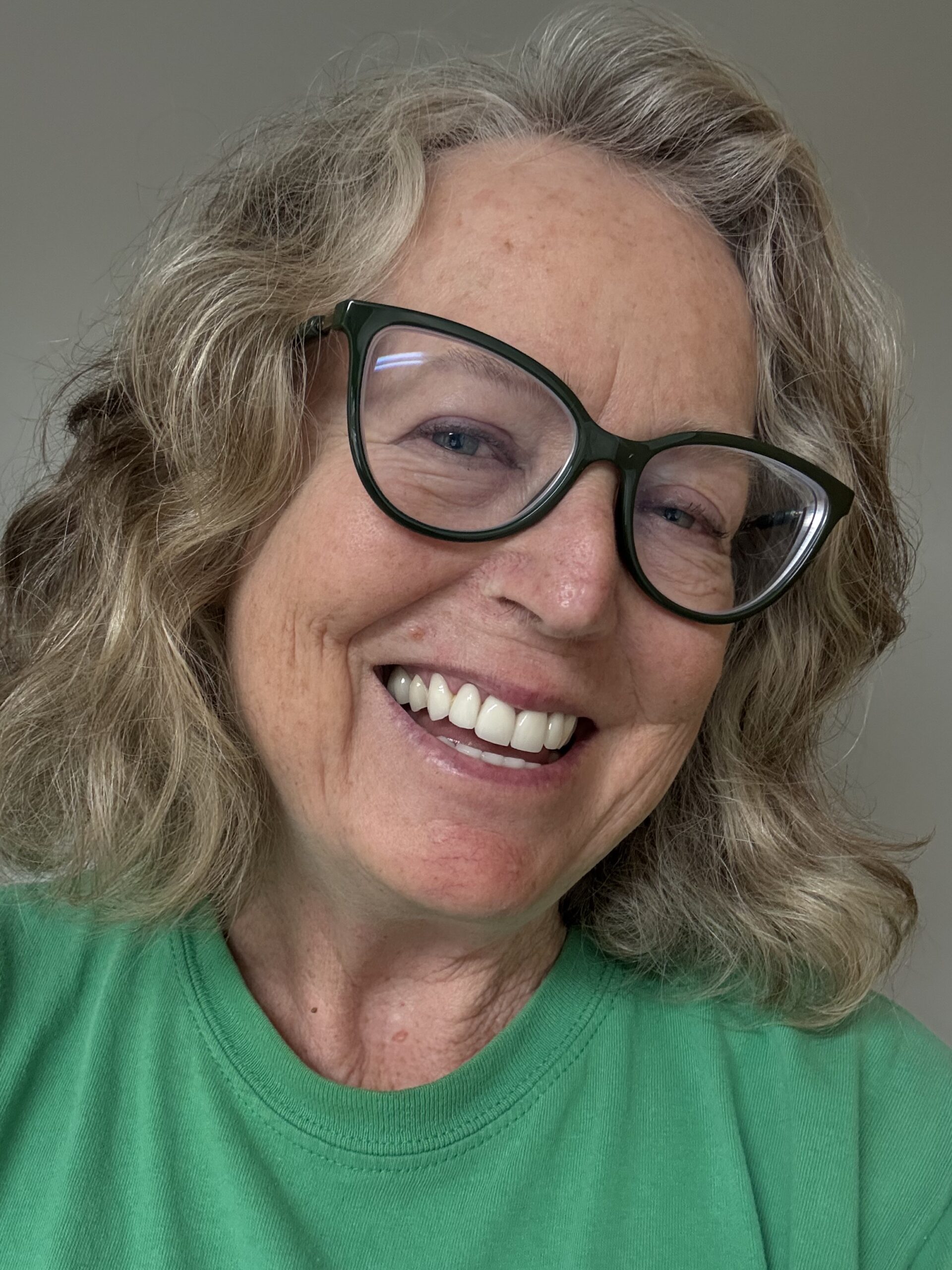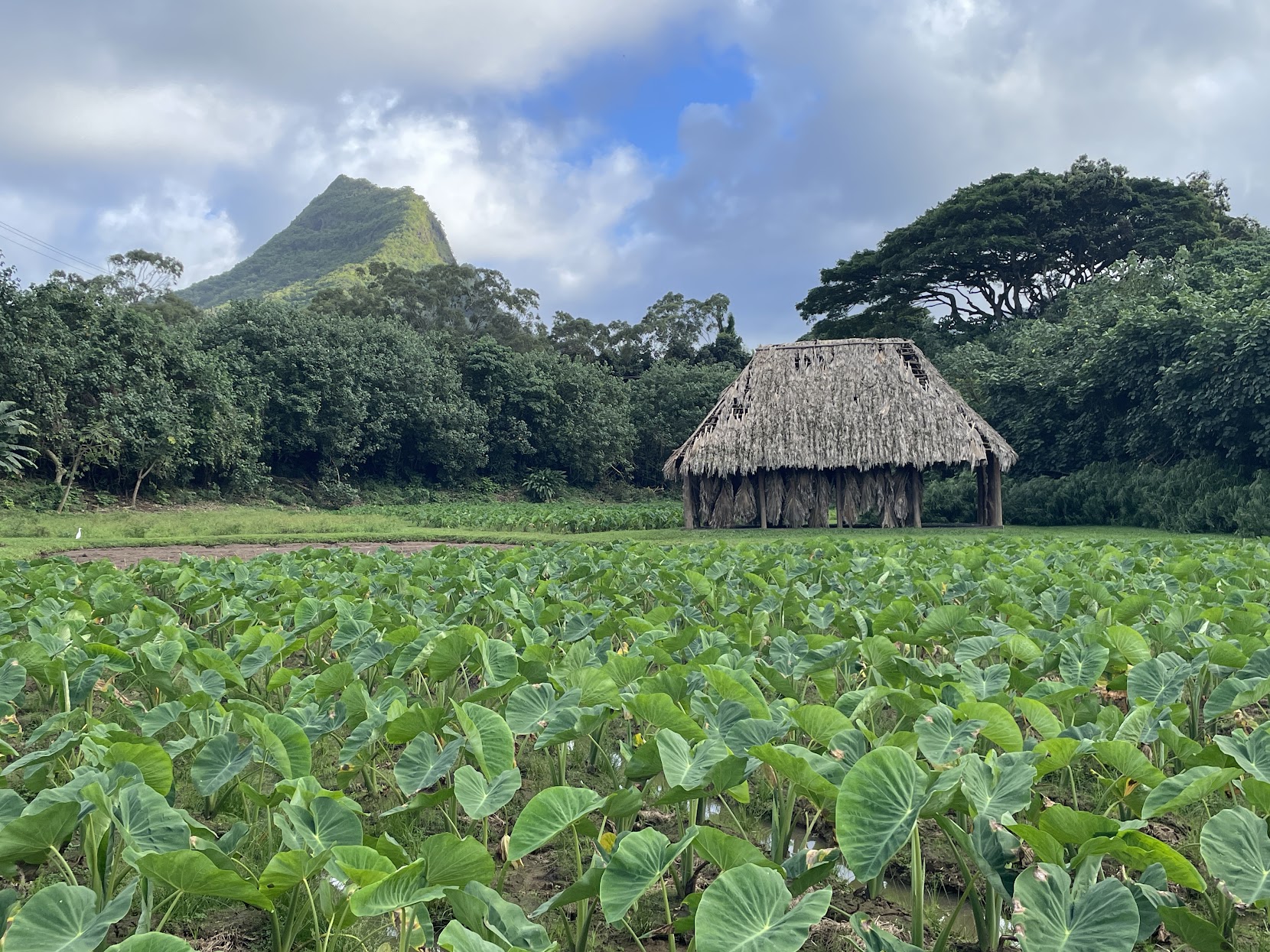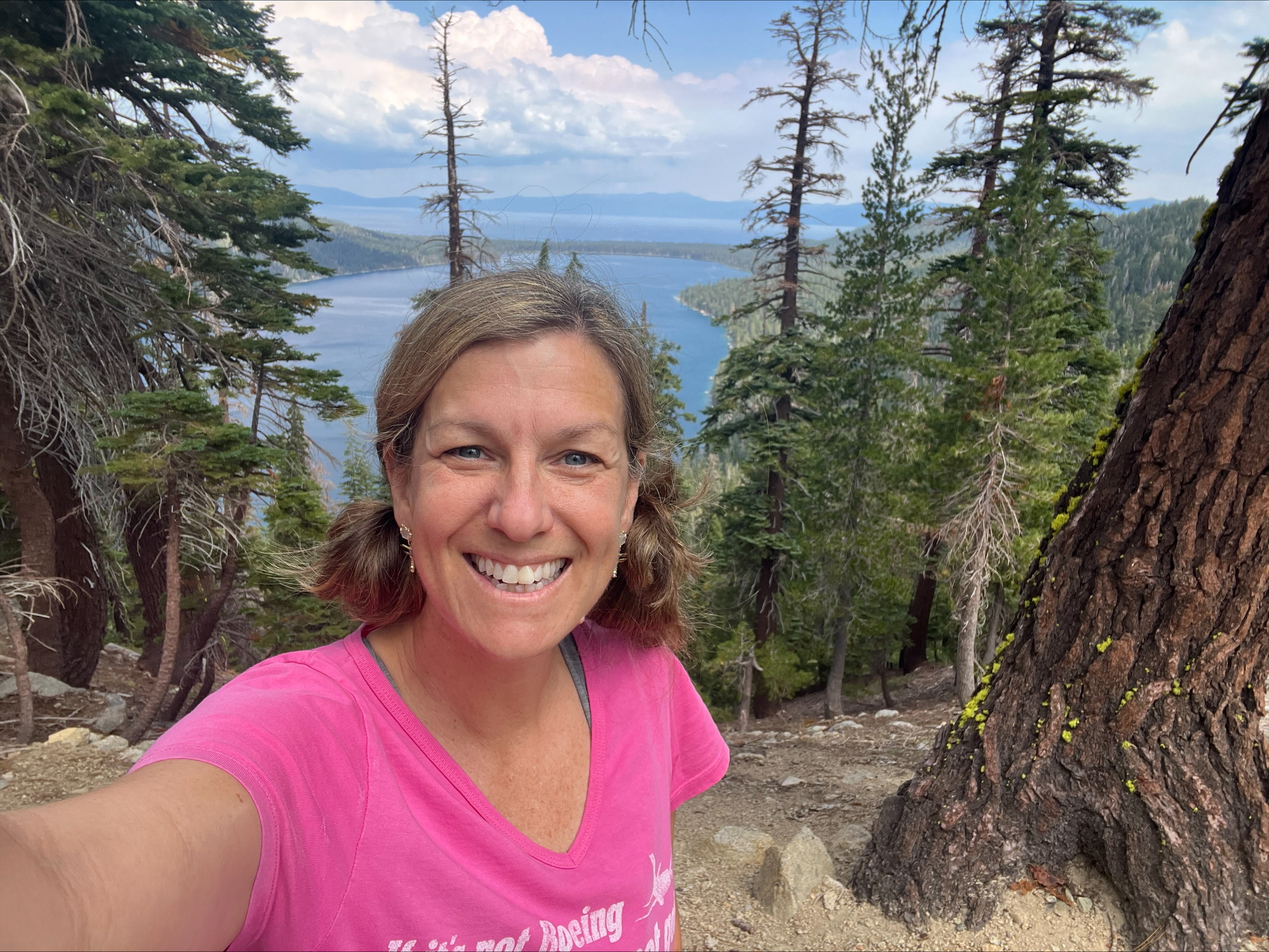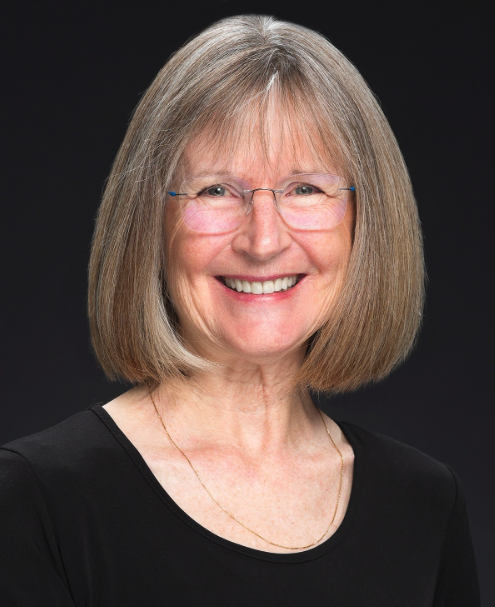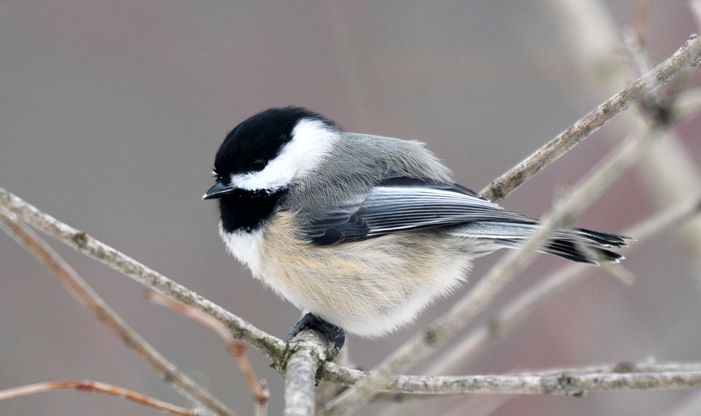Elaine Heath is the abbess of Spring Forest, a new monastic community in Hillsborough, North Carolina. Spring Forest centers around communal prayer and meals, a vibrant farm, refugee support, and other ministries you can read about here. You can learn more about Elaine’s work as an author and speaker on her website, or in articles like this one from the Center for Action and Contemplation.
Many thanks to Elaine and her husband Randall for welcoming Ron and I and our audio producer, Colin, to the farm last June. Besides relishing the good company of our hosts, we enjoyed harvesting cabbage, feasting and praying with the Sunday evening group, walking through the woods, and petting some good-natured goats.
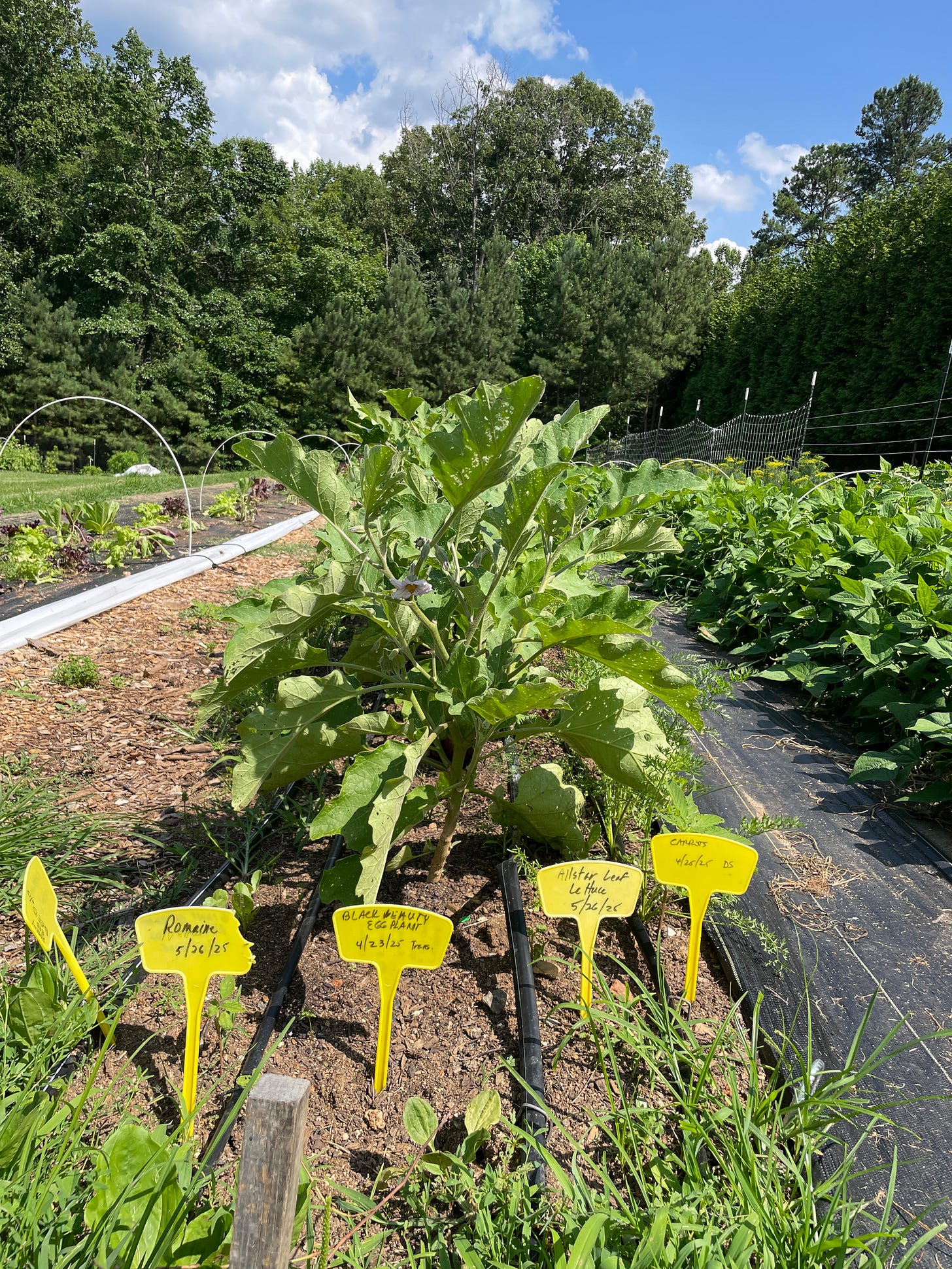
On the farm.
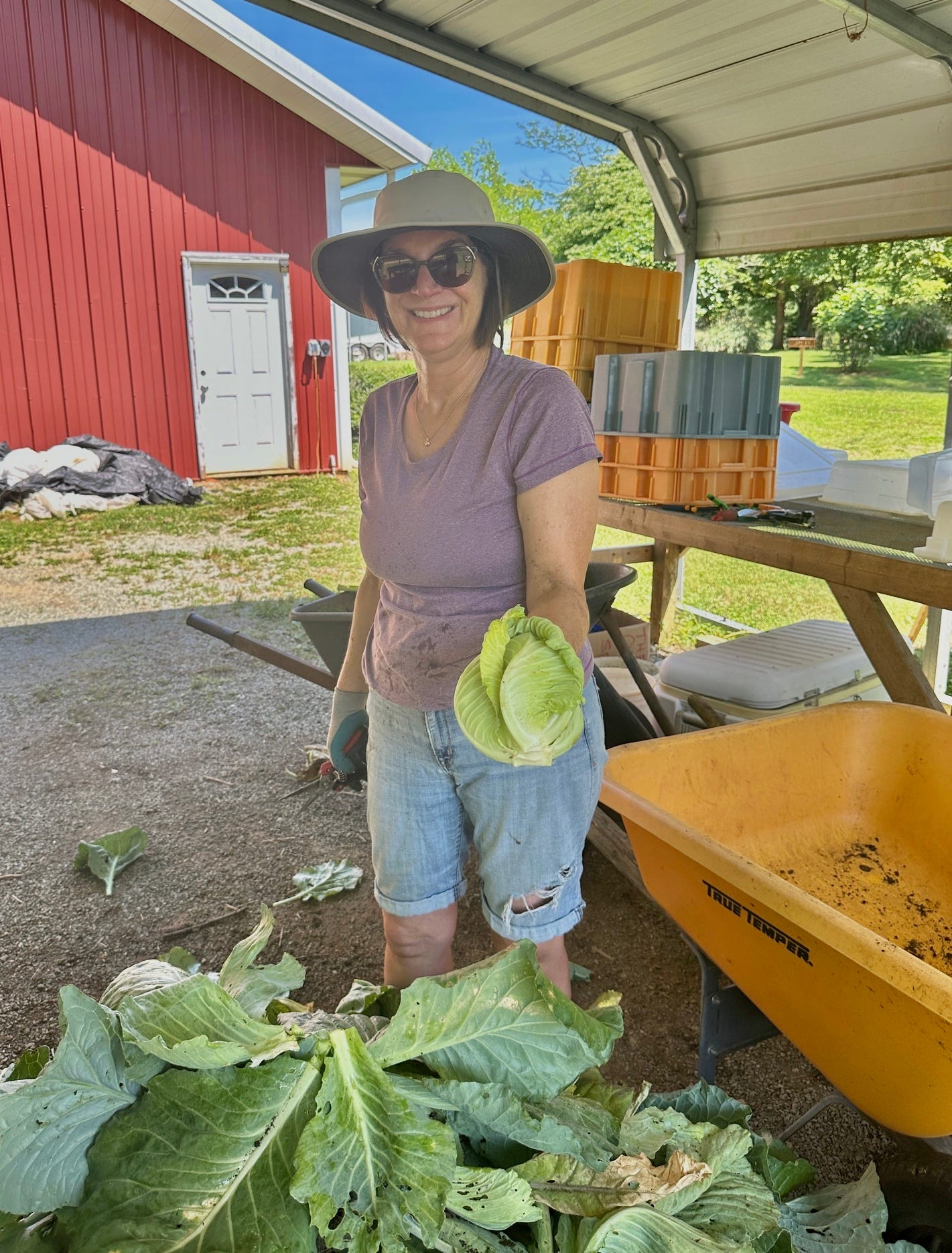
Someone had to help harvest the cabbage, so Ron and Colin and I pitched in.
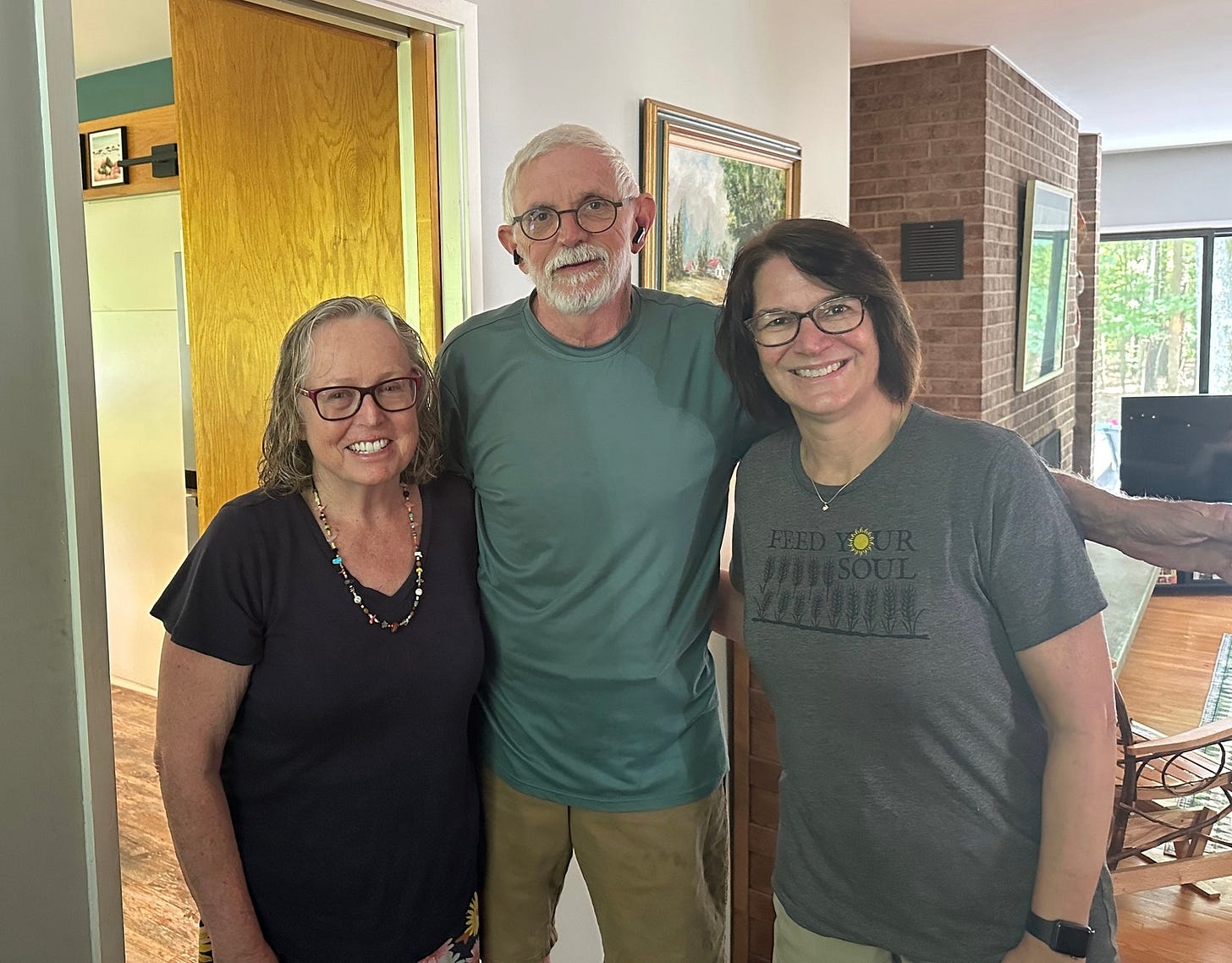
Elaine, husband Randall, and I in their lovely home.
TRANSCRIPT
Elaine Heath
If you are nurtured by traditional church—or let’s say, conventional church—keep doing it, but also realize that for other people that’s not nurturing. It feels dry and lifeless, and it’s clear the Spirit is doing something new. So instead of insisting everybody stop doing the new thing, and everybody has to come and do the conventional thing, you can be conventional in your worship and bless and make space for others so that we have a plethora of experiments going on.
Debra Rienstra
Welcome to the Refugia Podcast. I’m your host, Professor Debra Rienstra. Refugia are habitats in nature where life endures in times of crisis. We’re exploring the concept of refugia as a metaphor, discovering how people of faith can become people of refugia: nurturing life-giving spaces in the earth, in our human cultural systems, and in our spiritual communities, even in this time of severe disturbance. This season, we’re paying special attention to churches and Christian communities who have figured out how to address the climate crisis together as an essential aspect of their discipleship.
Today, I’m excited to introduce you to Dr. Elaine Heath. Elaine is founder and abbess of Spring Forest, a new monastic community centered on a 23-acre forest and farm property near Hillsboro, North Carolina. The farm supplies a CSA and supports food security for refugees and serves as the setting for outdoor programs for kids, cooking classes, potlucks, forest walks and more. But the Spring Forest community is a dispersed network of people who move in and out of the farm space in a variety of ways. They live on the farm for a time, they visit often to volunteer, or they simply join the community online for daily prayer. We got to visit the farm last spring, and I can tell you that Elaine’s long experience with new monasticism, trauma-informed care, and contemplative practice make her an ideal curator of refugia space. The vibe on the farm is peaceful, orderly, and full of life. It’s a place of holy experimentation in new ways to form Christian community and reconnect with the land. Let’s get to it.
Debra Rienstra
Elaine, thank you for talking with me today. It’s really great to be with you.
Elaine Heath
Yeah, I’m glad to be with you too.
Debra Rienstra
So you served in traditional parish ministry and in religious academia for many years, and then in 2018 you retired from that work to found Spring Forest. Why a farm and a new monastic community? What inspired and influenced this particular expression of faith?
Elaine Heath
I’ve always loved farms and forests. But actually, my dream to do this started about 25 years ago, and my husband and I bought a 23 acre property in North Central Ohio, right when I was right out of my PhD program and I got my first academic job at my alma mater, which is Ashland Theological Seminary. So I went there to direct the Doctor of Ministry program, and we bought this beautiful property. It had a little house that looked like the ranger station, and it had a stream and a big labyrinth cut in the field, and it had beautiful soil to grow, you know, for market gardening. And what we planned to do was gradually develop retreat ministries there. My husband was going to build some hermitages up in the woods, because I did a lot of spiritual direction with pastors who were burned out and traumatized, and we felt like that, you know, as I got older and phased out of academia, that would be something we could do together.
So we were there for a couple years, and then I was recruited to go to Perkins School of Theology at Southern Methodist University. And we were very sad to leave our property behind, but we were clear that we were being called to Texas. So we bought a home in the city in a sort of mixed income, racially diverse neighborhood in Garland, and it was a big house with a nice yard, and soon after starting to teach evangelism—which, I kind of created my own path for how to teach evangelism, because I don’t believe in selling Jesus or any of those kinds of colonizing things. So I was teaching about living a contemplative life and practicing social and environmental justice and being good news in the world, and being good neighbors to all our neighbors, and thinking of our neighbors as us and not them. And I had them reading Shane Claiborne and the people writing with the emerging church movement at the time, and pretty soon, I had students in my class coming to my office every week. It was a different student, but the same tears and the same kind of narrative: “Dr. Heath, I think I’m going to have to leave the church to answer my call. Tell me what I should do.” And it was because they were being called to do innovative, new monastic ministry, missional, new monastic kinds of things. But our denomination in particular didn’t quite get it, even though early Methodism was very much like that.
So I realized fairly quickly that this was God calling me through these students to focus my research and writing and my teaching in the area of emergence. Emergence theory, what’s happening in the world. How do these currents of emergence intersect with what’s happening politically and environmentally, and what’s happening, you know, in the economy and with the church. So pretty soon, I don’t know, it wasn’t very long, I felt God was calling me to gather students and start some experiments outside, out in the city. And so I had a prayer partner, and we were praying for a house to come available, so that we could start a new monastic house. And she came to me one day and she said, “I saw the house coming. It’ll be here soon.” And I said, “Okay.” I had no money for a house. You know, kind of a lowly professor, didn’t make that much. And within two weeks, one of our neighbors came to me, who didn’t really know me well at all, and said, “Hey, my mom has a rental property. It’s been in our family for a long time, and we wondered if you might have some students that would like to live there. We won’t even charge rent, just pay their utilities and not have drug parties or whatnot.” And I said, “No, that’s unlikely,” you know. So I said, you know, I could throw the phone down and ran down to get in her car and go over to this house with her. And we were driving over, and she says, “You know, it’s not the best neighborhood.” I said, “Perfect!” But we got there, and it was a really great little three bedroom house in a predominantly Latina neighborhood, and that was our first new monastic house. So I asked three of the students who’d been crying in my office, “Would you be willing to break your leases wherever you live and come and live here for a year?” And I can assign a spiritual director to work with you, and I can write a curriculum for an independent study on the theory and practice of new monasticism. And we can develop a Rule of Life based on our United Methodist membership vows. And they all immediately said yes, and so that’s how we got started with our first house.
Elaine Heath
And then right around the same time, I started a missional house church that was quickly relocated into the neighborhood where most of the refugees are resettled in Dallas, because one of my students brought six Congolese men to our little house church worship, and that that was the beginning of realizing we were called to work with refugees.
Debra Rienstra
Oh, I see.
Elaine Heath
So that all got started around 2008. And by 2009, there was a student who came to Perkins who had been a commercial real estate banker on Wall Street. And he came to Perkins as a student. He was an older man. And we were going on my very first pilgrimage to Iona, Northumbria, and Lindisfarne, and Michael Hahn was with us too. He and I team-taught this class, so it was my first one. But it turned out that Larry Duggins, the student, had come to seminary because he really wanted to be equipped to help young adults who were feeling disillusioned with the church but wanted to be out in the world doing good work. And he started describing what he was called to, and I’m like, “Well, that’s what I’m doing with these students.” So we joined forces and created a nonprofit called Missional Wisdom Foundation, and within three years, we had a network of eight new monastic communities across the metroplex. They were all anchored at local churches. Some of them were parsonages that weren’t being used. And we wove into the expectations and sort of the lifestyle of those houses, urban agriculture.
Debra Rienstra
Oh, I was waiting for the farm to come back into it. Yeah, because I’m seeing these threads of experimentation and monasticism and place. We’re sitting here today on your current farm land. So it’s really interesting to hear all these threads being developed early on in an urban context.
Elaine Heath
Yes, it was quite something. These houses were all in different social contexts. There was one house, the Bonhoeffer house, that was in East Dallas, in a neighborhood that was not only mixed income and racially diverse, but also used to be where the mayor lived. And now there are people who are unhoused living there, and there are also people with nice houses living there. So it was a very interesting neighborhood. So that house, we learned quickly that you needed to take a year to get to know the neighborhood before you try to figure out how you’re going to support whatever justice work needs to happen in the neighborhood. But that house got really close with the unhoused community and did a lot of good ministry with the guys and a few women. Then there was one for undocumented workers, the Romero House, and just different social contexts. But all of them had a backyard garden or, you know, some type of growing food kind of thing. And I used to take students to this farm that was an urban farm in DeSoto, which is just south of Dallas, where it was quite small, but these were former missionaries, the type that have crusades and show the Jesus film and everything in sort of poor countries. And then they had an awakening that happened, and they realized they were being called to help people in orphanages learn how to grow their own food in a sustainable way and raise the living standard for the whole village. So they had this little farm, and I would take students there every semester to experience the conversion of thought that this couple had over what mission is, and to experience the beauty and joy of tilapia that provide food for the lettuce, that provide for the bees, you know. So this closed system. So that also affected my imagination about what I really wanted to do in the future.
And so gradually, the years—we were there for 11 years, and we lived in community the whole time that we were there. By the time we came here for me to work at Duke, we had a very clear picture of what we wanted to do here. And so we looked for the property back when we had to sell that first farm, when we were so sad about selling it, I had an experience in prayer where I sensed God was saying to me, “Don’t give up on this dream. It’s sacred, and it will happen in the future on a better piece of property, at a better time in your life for this.” And so when it was time to move here, I said to Randall, “This is the time. Let’s look for that property.” So that’s how we landed here.
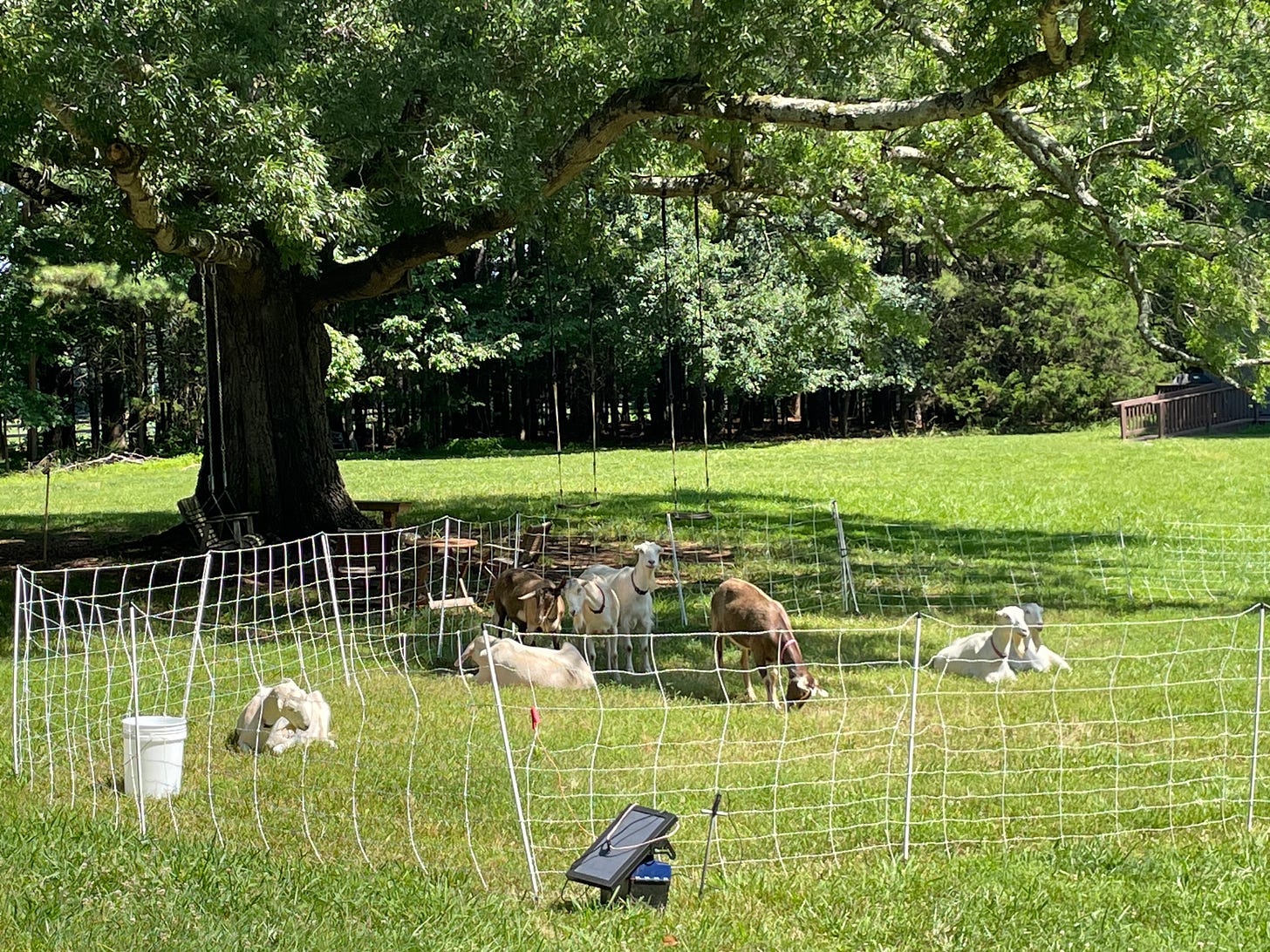
Friendly, very contented dairy goats, hanging out in the afternoon.
Debra Rienstra
Yeah. When talking about your students, you mentioned yesterday that you like to “ruin them for fake church.” So what do you mean by fake church, and how exactly do you ruin them for it?
Elaine Heath
Well, you know, church is really the people and not the building. You all know that. It’s the people and we’re called to be a very different kind of people who are a healing community, that neighbor well, that give ourselves away, that regard our neighbors—human and non human—as part of us, whether they think they’re part of us or not. We have this sort of posture in life. And when I think of how Jesus formed the church, Jesus had this little ragtag group of friends, and they traveled around and did stuff and talked about it, and they got mad at each other and had power struggles and drama and, you know, and then Jesus would process the drama with them. And he would do these outrageous things, you know, breaking sort of cultural taboo to demonstrate: this is what love really looks like. And so we don’t get to do much of any of that, sitting in a pew on Sunday morning, facing forward while the people up in the front do things. And so many churches—maybe you’ve never experienced this, but I certainly have. The pastor’s sort of the proxy disciple while people kind of watch and make judgments and decide whether or not they want to keep listening to those sermons.
Debra Rienstra
Oh yes.
Elaine Heath
So when you experience Christian life in a community where it’s both natural, it’s just the way you live in the world, and it’s also liturgically rich, and the life is a contemplative life, and it’s also a life of deep missional engagement with the world— that other version of church, it’s like oatmeal with no flavoring in it. It makes you, I mean, it’s about the life together. It’s how we live in this world. It’s not about sitting somewhere for an hour once a week and staring forward.
Debra Rienstra
Right. Yeah, so I would, you know, of course, I would describe what you’re describing as refugia, being the people of refugia. You know? Not that I’m—we’ll come back to traditional worship and traditional forms of faith and religion. But it seems like what you’re doing is living into something you say on your website that we are in the midst of a new reformation in the church, and I certainly sense that too. I think the evidence is all around us, and the research bears out that we’ve reached this inflection point, and it’s a painful inflection point that a lot of people think of as decline, because living through it feels confusing and bewildering and dark and full of loss. So what is your sense of when we are, in this point in history, in particular, for those of us who’ve been part of church communities, where are we finding ourselves? Why is it so confusing?
Elaine Heath
I really believe we’re in a dark night of the soul as the church in the West and perhaps places in the East too. I know we’ve exported a capitalist version of church all over the world, sadly. But I believe we’re in a dark night of the soul, you know, classically understood, where it’s spirit-breathed. It’s not that the devil is doing something to us. It’s spirit-breathed to detach us from our sort of corporate ego that thinks we get to show up and boss the world around and act like we own the joint.
Debra Rienstra
We call that church of empire.
Elaine Heath
Yeah. And so I think that’s what’s happening. And when, you know, if you study the literature, if you work in spiritual direction, and you’re looking at what happens with the dark night of the soul. That’s a real dark night, not a clinical depression or something like that, but an actual dark night. You have to go through it. You can’t bypass it. You can’t work your way out of it. You can’t talk your way out of it. And what happens is you find yourself increasingly hungry for simplicity, for a simple but clear experience of God, because it’s like God’s disappeared. There’s a deep loneliness, even a sort of cold hell, to being in a dark night of the soul. And so there’s a restlessness, there’s a longing for actual experience of God. There’s a feeling of futility. Things that used to work don’t work anymore. So you know the threefold path? The purgation, illumination and union is one way that we’ve learned to think about what happens. The purgation part is— we’re there.
Debra Rienstra
We’re being purgated.
Elaine Heath
We’re being purgated, yeah. And at the same time that we’re having these flashes of intuitive knowing, this sort of illumination is coming. “Oh, let’s pay attention to the saints and mystics who lived through things like this. What gave them life? What helped them to keep showing up and being faithful?” And we’re having moments of union too, when we feel like, “Oh, discipleship means I make sure that the trees are cared for and not just people. Oh, all living things are interconnected. Quantum physics is teaching us a spiritual truth we should have known already.” So the three parts of that contemplative path are happening simultaneously. But I think what feels most forward to a lot of people is the purgation piece where you’re like, “Oh, things are just dropping away. Numbers are dropping. Things that used to work don’t work. What’s going to happen now?” Sort of a sense of chaos, confusion. Tohu va bohu, yeah.
Debra Rienstra
Yeah, do you want me to explain what that is?
Elaine Heath
Yeah, chaos and confusion. From the beginning of time.
Debra Rienstra
It’s the realm out of which creation is formed. So the idea that the spirit is drawing us into this dark night is actually really reassuring. We are where we’re supposed to be. And even though it feels confusing and painful, there are these moments of wisdom—that’s so reassuring. In fact, one of the things you write: the new reformation is all about the emergence. So this emergence is happening of a generous, hospitable, equitable form of Christianity that heals the wounds of the world. What is your vision about what the church needs to release and hold and create right now?
Elaine Heath
We need to release everything that even slightly has a hint of empire, that we have thought of as what it means to be the church, because that completely reverts what church is supposed to be about. So giving up empire, we need to take up the great kenotic hymn of Philippians two and actually live it.
Debra Rienstra
The self emptying hymn.
Elaine Heath
The self emptying. And it’s not—I know that that can be problematic when we’re thinking of women or, you know, groups that have been forced to empty themselves in an exploited way. But that’s not really what that’s all about. It’s about showing up to God, paying attention, seeing what God’s invitation is, then cooperating with that and just releasing the outcome. That’s what that’s about, and really finding out, what am I in this world for? What are we in this world for? And being about that and not about something else.
Debra Rienstra
Yeah, it’s hard to release the ways that we have done things. Well, you have a congregation, you have a pastor, you have a sanctuary, you have programs, you want the kids to come, you need tithes, all of those systems. And actually, what you’re doing here at Spring Forest—let’s talk about that. What you’re doing here at Spring Forest doesn’t have any of that. Sunday services. There’s no church building. You have barn buildings, you have farm buildings. No Sunday school, no adult ed, no choirs, organs, praise bands, any of that stuff, right? Do you think of Spring Forest as a new model for church? Perhaps one among many?
Elaine Heath
It’s one among many. We’re definitely shaped by traditional monasticism. We’re shaped by early Methodism. We’re influenced by the Catholic Worker Movement, and definitely Bonhoeffer’s work and a number of others: the Clarence Jordan and Koinonia farms. And so we’re influenced by all of those. We do have music sometimes at Forest Feast, if we have someone that can lead it, and, you know, do a good job. But the backbone of our worship life is morning and evening prayer. And that is so wonderful. You were here last night for Forest Feast, and we use the same structure we use for morning and evening prayer, and we have a group of about six people who are writing the liturgies for us, who have been writing for a year and a half now.
Debra Rienstra
Who are those people?
Elaine Heath
Well, there’s Steve Taylor is our lay leader, and his wife, Cheryl, and then there’s Donna Patterson, who’s—none of them were here last night. They all had to go somewhere. But some of them are lay people. Some of them are clergy.
Debra Rienstra
And they don’t live here?
Elaine Heath
No, they live— well, some of the people that write live far away, and they’re in our digital community. But, yeah, Steve and Cheryl live in Lumberton, which is, you know, almost two hours away. But they’re beautiful. I mean, if you go online and look at some of the last month, look at the prayers and see the—they’re just truly beautiful, and they reflect our spirituality of our community.
Debra Rienstra
Yeah. So the community, it seems to me, you have had people living on the farm itself, but your community, like the Iona community, is both located here on this land, but also dispersed. And so you have that interaction, that conversation between this residential life. So let’s try to describe for listeners: there’s the farm. You live here with your husband. You have interns from Duke. You have a farm. What do you call Larry?
Elaine Heath
He’s our farm coach.
Debra Rienstra
Coach, yes, I love that. They have the farm coach who has the farming knowledge that you all sort of follow. You have chefs. They don’t live here either, but they come in. So you have a lot of people coming in and out on this farm. And you do regenerative farming. You have programs for kids, you have refugee support, and you can talk about that, trauma informed rest for spiritual leaders. And then a number of other things. The farm produces vegetables and those go to a CSA, and also a lot of it is donated. Why this particular assembly of activities? How does it all fit together? And what are the theological principles beneath each of these endeavors?
Elaine Heath
The overarching principle is that the Holy Spirit gives gifts to every believer and to every person, let’s just be honest. And the job of the pastor, the pastor teacher, is to fan those gifts into flame, to help them have the support they need to use their gifts and that the ministries should be shaped by the gifts of the people, which means you can’t use a cookie cutter. And we have numerically a small community, but incredibly high capacity of people. So we have these gifts that they have, and then the ministries are emerging out of those gifts. And it might seem like, why do you have refugee support? And you know, just name anything else we’re doing. How does this fit together? The organizing principle—okay, so you have the foundation. These are gifts given by the Spirit. Our ministries are emerging from our gifts. And the organizing sort of a cohesive piece is our rule of life that ties everything together. And so our rule of life is prayer, work, table, neighbor and rest. And that rule of life came about after we lived here for a year, when we first started Spring Forest with—there was another pastor that co-founded it with me, Francis Kinyua, who’s from Kenya, and he was my student in Dallas, and did all those other things with me. So we invited him to come. We had to work with three different bishops to kind of make it work. But it worked, you know. Anyway, we just waited for a year to see. We had lots of work to do with getting the farm ready to go and Francis and I went to Church World Service right away to say, “Hey, we have a lot of experience supporting refugees, and we would like to do that here as well.” So we got started with that, but we waited a year and then just articulated, what are the practices that we do that are keeping us grounded here and keeping us right side up. And it was those things, so we named it.
Debra Rienstra
Okay, you were just doing it, and then you named those things.
Elaine Heath
Instead of creating sort of an aspirational rule and tried to live into it, we named what was actually working, what was actually grounding us and felt life giving.
Debra Rienstra
Hi, it’s me, Debra. If you are enjoying this podcast episode, go ahead and subscribe on your preferred podcast platform. If you have a minute, leave a review. Good reviews help more listeners discover this podcast. To keep up with all the Refugia news, I invite you to subscribe to the Refugia newsletter on Substack. This is my fortnightly newsletter for people of faith who care about the climate crisis and want to go deeper. Every two weeks, I feature climate news, deeper dives, refugia sightings and much more. Join our community at refugianewsletter.substack.com. For even more goodies, including transcripts and show notes for this podcast, check out my website at debrarienstra.com. D-E-B-R-A-R-I-E-N-S-T-R-A dot com. Thanks so much for listening. We’re glad you’re part of this community. And now back to the interview.
Debra Rienstra
You do partner a lot with, you know, “regular church folk.” It’s that sort of in-and-out permeable membrane. How do you think about the relationship of what you’re doing here, with Spring Forest, with the work of sort of standard congregations, is there like a mutuality? How do you think about that?
Elaine Heath
It’s just like traditional monasticism. You’ve got a community that have this rule of life they follow. People who are not living in the community can become Oblates to the rule of life and have a special relationship. And usually those people go to church somewhere else. Part of our ethic here is we want to resist competition between churches, so we don’t meet on Sundays to do things like programmatically. We usually just rest on Sundays and watch a movie and eat popcorn, you know.
Debra Rienstra
That’s a spiritual practice.
Elaine Heath
But also, so there’s that sort of historic piece, and people from churches come here for retreats. Lead teams come for retreats. People come—pastors, we have a lot of pastors who come here for a retreat. But also we are a mission community, so we’re very active with supporting refugees. We’re very active with the food programs that we have, and that gives people from a church—lots of churches don’t have things like that going on. They don’t have the resources for it, or they haven’t figured it out. But that way, we can partner with churches and people can come here and they can actually get their hands in the soil, and they can teach somebody to read, and they can see little children learning where food comes from. They can help the chef with her kitchen things, you know. So it’s a wonderful way to provide spiritual formation and missional formation to congregations that don’t have those resources. And we can do these things together.
Debra Rienstra
Yeah. And that’s that’s premised on this being a place, an embodied place, a refugia space that people can come to. Yeah. I think that’s a wonderful model. Do you yourself ever feel a sense of loss for “the old ways?” And I’m just thinking of this because at the beginning of your book, God Unbound, which is about Galatians, you write about how Paul challenges the Galatians to let go of their tight grip on the past, and you write about how you, reading that, felt yourself like a little bit of a traditionalist, you know, sort of defending, “But what about the past? What about the old ways?” Which you have loved too, right? So, how would you counsel people who have loved traditional church despite everything, and really do feel this sense of loss and wonder anxiously about what’s next?
Elaine Heath
Yeah, I feel empathy. You know, something was going on in the Middle East at the time. I can’t remember exactly the situation. There’s always something going on, but it had to do with people’s culture being wiped out and being told that what they believed didn’t count and wasn’t right and everything. And I was feeling such grief for them, and then all of a sudden, you know, I’m in Galatians, and think, “Well, that’s how those people felt.” And even myself, there are things in my own daily practice that are—they’re precious to me. My way of praying in the morning, the facing into the forest, you know, and things like that, that are rituals for me. And thinking, you know, if somebody told me “that doesn’t matter,” how hard that would be. So I think in the spiritual journey, we come to the place, if we keep maturing, where we realize, in Merton’s words, that so often we think it’s the finger pointing to the moon, we think the finger is the moon. And it’s that way about rituals and all sorts of things that we do, and we get to a place where we realize that intellectually and even spiritually, in an emotional way. But you can’t force people to get to that point. This is something that happens as we grow and mature as life goes by. So what I have said to many people is, “If you are nurtured by traditional church, or, let’s say, conventional church,”—because which traditional church are we talking about? One, right here, middle class, white, are we talking about Brazil? —”So if that nurtures you, keep doing it. But also realize that for other people, that’s not nurturing. It feels dry and lifeless, and it’s clear the Spirit is doing something new.” So instead of insisting everybody stop doing the new thing, and everybody has to come and do the conventional thing, you can be conventional in your worship and bless and make space for others so that we have a plethora of experiments going on. Because we’re in a time of great emergence, as Phyllis Tickle wrote, and we need lots of experiments.
Debra Rienstra
Yeah. I appreciated what you wrote about trial and error. It’s a time of trial and error, and it’s okay to try things and have them not work. And that fits the refugia model too, really, really well. I mean, refugia don’t always work. They just sometimes fail. Let’s talk about a couple of key metaphors that I’ve noticed in your writings and in the website for Spring Forest too. One is that metaphor of the mycelial network, so the underground fungus that connects the creatures, the beings, the plants, the trees of the forest. I think is a wonderful metaphor too, for the way that faith and climate people, people who are worried about the climate crisis, and also people of faith—it’s a great metaphor for how they’re finding each other and connecting and building this sort of cultural and spiritual soil where the seeds of the future can grow. How is that metaphor meaningful for you here at Spring Forest?
Elaine Heath
Well, it means a lot in terms of the first of all, the diversity of expressions of ministry that are even here on the property, but also, especially in our dispersed community, through following the rule of life together, which—we are a practice-based community, rather than a dogma-based community. So as people are practicing those practices where they live and work and play, then they are forming community in a very specific, contextual way where they are. I think of Steve and Cheryl again, the friends I mentioned earlier. He’s our lay leader. They live in a, I think a working class neighborhood in Lumberton, which is the land of the Lumbee here in North Carolina. And they have developed a wonderful, just neighborhood ministry there with—and they’ve been able, through potluck dinners and front yard barbecues and remembering people’s birthdays and things like this, they’ve developed this friendship network in the neighborhood with people that are on complete opposite sides, politically, racially, and this is in the South, where you’ve got all sorts of issues. And they’ve taken the sort of ethic of Spring Forest here, but it’s caused a mushroom to bloom there that looks really different from here. They don’t have a farm, they don’t have a forest, they’ve got this neighborhood. But the neighboring, the praying, the tabling, resting, all of those things are part of how they live there. And so it’s fruiting there. And it’s the same in other places in the world where we have people that live there.
Debra Rienstra
It’s a good example, too, of how eating together is sacramental, both here and in these other networks that are connected to you. The Garden of Eden and the vision of the New Earth in Revelation are both important to you, that that whole long scriptural arc begin in a garden, end in a garden city, and then the Tree of Life is also your symbol, your logo. So how would you situate our work today as people of faith in that long arc of history, from the garden to the Garden City, and how does the Tree of Life fit into that for you?
Elaine Heath
There’s a way in which the whole story is happening simultaneously. Does that make sense?
Debra Rienstra
Yeah.
Elaine Heath
It’s all happening beyond time, sort of simultaneously. So sometimes we’re living in the garden and we’ve been deceived, and now we have to figure out what to do, and sometimes we’re rebuilding the wall, and sometimes we’re on our way to Bethlehem, and sometimes we’re in the garden of the new creation. And we can see it, and we’re living that truth even while there’s still the wall being built. There’s a simultaneity to it all. But for me, I think especially of the theology of Julian of Norwich. That’s why we have her icon here. There’s this vision of love making all things new, that God, Christ, the risen Christ, says in Revelation 21:5, “Behold, I make all things new.” All things, not just a handful of people who get the right doctrine, not just—no, all things: horses and amoeba and all things are being made new in mysterious ways that we can’t completely know.
Debra Rienstra
And that’s Colossians one and Romans eight as well.
Elaine Heath
It’s this thread that comes through scripture, and we get to participate in that, even while we don’t see all the things completely made new, we get to be part of that. And to me, that’s what it means to follow Christ. That’s what it means to be a disciple. And to be the love of God enfleshed in this world is to keep participating in the making of all things new. This is why healing has such a central role in my theological vision and my practice, is it’s making all things new.
Debra Rienstra
Healing land, healing people, healing communities.
Elaine Heath
Yeah, yeah. Healing theology. Theology has been so damaged by patriarchy and philosophy and all sorts of things, you know, and racism.
Debra Rienstra
Colonization. Yeah, so that embodiment is important even theologically, because we’re not aiming for some abstract doctrinal perfection. We’re not aiming to become disembodied creatures. We’re aiming for this embodied redemption. And so working on the farm, healing, you know, getting muddy, walking through forests, harvesting veg, and you’re able to invite people into that embodiment. Little kids doing yoga, I think that’s wonderful. You know, just finding this kind of rest in their own little bodies. Eating—one of the most embodied and kinship-with-creation things we do, right? Taking it inside ourselves. And that, I think, is condensed in ritual. So I know that you have been playfully experimenting with rituals. I was able to be a part of the Forest Feast last night with my husband Ron and our friend Colin. And it was this beautifully curated event where we shared table together and then went through this prayer sequence that you described, and it was beautifully participative. I noticed you do a blessing of the animals too on the farm. So good thing these are blessed chickens and blessed dairy goats, blessed dogs and cats. What other sort of liturgical shenanigans have you tried to help people live into this embodied faith practice?
Elaine Heath
We do so many things. It’s so much fun. It’s never boring. It’s never boring. We have a ritual in the fall, in late November, where we tuck the farm in and put it to bed for the winter, and we have the children come, we get some compost. You know, we’ve cleared out the beds, and they’re gonna rest now. And so the children put some compost in. And we have a liturgy that we use. We light candles, and we thank Mother Earth for the food, we thank God for the opportunities. And so this is one of the things that we do ritualistically. We also have a spring ritual. It’s very Hebrew-Bible like, right? With these seasons and the crops and the things with the liturgical seasons, we also have done a bunch of things. My favorite one so far was for epiphany, and this was two years ago. And so I had the interns from Duke Divinity School do the bulk of the planning. I just gave them a little bit of guidance about the four-fold order of worship and just some things like that. So we had a journey through the forest. It started here. We went on the forest trail. Of course, it was dark outside, and they had gone ahead and set up fairy lights at certain places where we’re going to stop. And one of the interns’ fiance was a musician, so he had his guitar, and he had one of those things where you can play the harmonica and play the guitar at the same time, but he was our troubadour, and all of us were the Magi. So there’s this troop of Magi, and we would stop at each station along the way, and there were prompt questions that we would take five minutes, and people could respond to these questions. There would be a scripture reading, and we respond to the question, we go to the next station. And it was so amazing. People shared from their lives in a very deep way. It surprised me how quickly they went deep. Well, it was dark, and there were these twinkle lights, and there was the troubadour. Then we finally got up to the Christ child, and we went into the goat barn. And honestly, I get chills every time I even remember this. But the students had set up in the goat barn—and the goats were in the barn. Okay, they were behind a little chain link thing so they didn’t step on the icons and everything. But they had set up an altar at the base of the feeding trough with a big icon of Mary with the Christ Child, candles, and some other things there. There were different icons and some fairy lights. And we went in there, and we all crowded in and began to sing. We sang “This Little Light of Mine,” we sang some Christmas carols, and finished the story. And then we came back to the house and had some snacks and talked about what kind of wisdom was given to us since we were Magi. We were going to be people seeking wisdom and seeking—it was the most beautiful thing. And we’ve done lots of things like that. We see the land here is a primary text to learn from and to listen to and to observe, not as a metaphor, but as, it’s actually a conversation partner. So we do things like that.
Debra Rienstra
That playfulness is so exciting to me, this sense of using our tradition, using our scriptures, using the skills that we’ve honed as people of faith over generations, singing together, praying together, but experimenting with those things in new contexts and new ways, in new forms of embodiment that are just faithful and yet playful. And so, as you say, people go deep because they’re sort of jarred out of their habitual ways, and that can be such a great formational moment and bonding moment too, and it’s very memorable. We remember that in ways—you know, you had such joy on your face as you’re describing that. What would you say as you look back over the last, well, let’s see, it’s been almost eight years? Seven, eight years here at this location. What would you say has given you the most anguish and what has given you the most joy?
Elaine Heath
Oh, anguish. Which story should I tell?
Debra Rienstra
Yeah, I don’t want to make it sound like it’s all been beautiful and romantic and perfect.
Elaine Heath
Whenever you have community, you have drama. Well, you know, at your typical church, you’re gonna have drama sometimes. But what we’ve found a few times, and it’s pretty predictable. This happens in traditional monasteries too, which is why they have novitiate periods that are sometimes quite lengthy and sort of staggered, like you put your toe in the water. People of very high capacity who are deeply grounded spiritually and have a real vision for the gospel, are attracted to community life like this. People who are really hurt, who’ve had a lot of brokenness, especially from religious institutions or abusive situations, trauma that that is unresolved, that has a lot of unhealed wounds, are also attracted to places like this, often with a sort of utopian hope, because of, you know, life’s deficits.
Debra Rienstra
And they feel that this is a place of healing, and they’re right about that.
Elaine Heath
They’re right about it. And so what actually happens is sometimes with the person, the second category of person, will come and join in and just be so full of gladness, because, “Oh, these, these are real people, like they’re really doing things in the world. This is what I’ve longed for.” But then, as relationships form, and we’re doing life together, and we all bump up against each other at times, the unhealed wounds fester. And the way I see it is, God’s bringing them to a place where, if they’ll just do their inner work now, now that it’s clear what’s the next step—if they’ll take the next step, whether it’s get some therapy, stay on your meds, get some support for your addiction recovery, whatever the things are—if you’ll take the next step, then this is a very supportive community that can help you. It’s a village that can be around you and you will heal here in the context of this village. But sometimes people are not willing or not able, or it’s not time in their own sense of what they can do, and so then they’ll leave. Sometimes when people leave, this happens in traditional churches, for whatever reason, this is a common sort of psychological reaction, they’ll create some sort of chaotic drama to be the excuse for leaving, rather than have to face the fact that it was time for me to take the next step, and I was too scared. Because that takes a lot of self awareness, you know, to come to realizations about things like that. So I know from talking to people, from, you know, friends that are in traditional monasteries and convents that this is a common thing that happens there. So it happens here sometimes, and it’s never easy. It’s always painful and always challenging, you know, but with God’s help, we get through it. And so that’s the anguish, when those kinds of things happen. We’ve had a time or two where, over the last 20 years, really, where a person would come in, usually a young adult who’s very idealistic, and they’re like, “This isn’t a new monastic community. You’re not forcing people to pray three times a day!” You know, whatever the thing is that they have in their head that is supposed to be, because we’re pretty gracious, you know.
Debra Rienstra
You don’t get up at three in the morning.
Elaine Heath
Yeah, that’s not us. We can’t do that because, especially if you’ve got families with children and, you know, you’ve got to get up and go to work in the morning. So sometimes there will be somebody that figures they know more than everybody else in the room, and they want to take over and run the joint. You know, that’s not going to happen. So then that sometimes creates some anguish. What about the joy? The joy is—and there’s so much to give me joy. I really, really love seeing people come alive, like I really love seeing people who have, especially people who have been harmed by religion, because of their identity or because of anything, and they find deep spiritual friendship. They find how to connect, in Buechner’s words, their deep passion with the world’s great need, and start a new thing. And it gives them so much joy. And it’s actually helping people. It’s helping the world. And just sort of fanning that flame, that gives me a lot of joy. I have so much joy being in touch with the land and the animals. I just really experience them directly mediating God to me. I feel the divine life in them, and I feel, I guess I get a lot of dopamine hits when I’m out there harvesting and when I’m, you know, brushing the goats and talking to the chickens and whatnot.
Debra Rienstra
They are blessed chickens!
Elaine Heath
They are blessed chickens.
Debra Rienstra
What advice would you give to church people who, even though they love their church and their community, recognize that something needs to change, but they don’t know where to start? What advice would you give?
Elaine Heath
To start in their own home, if at all possible, start in their own neighborhood. Start having neighbors over for dinner. Do not tell them we’re going to have a Bible study now, because that’s—it’s not to have a Bible study. It’s to form friendships with our neighbors. Start neighboring well. Figure out who lives on my street. Who lives across the street? Invite them for dinner. Have neighborhood potlucks. We did this in Texas, right after we moved there, I think they’re still going. We’d have 50 people in our house sometimes. But just invite the neighbors for dinner. Have a potluck. Get to know them. Remember their birthdays, go to their kids’ graduation. When you find out their mother died, go to the funeral. It’s so simple. It’s just such basic neighboring. That’s where to start. It’s not a church program. It’s not making you stop going to church somewhere, to go to church over here. What you’re actually doing is living church in your own neighborhood. Start doing that.
Debra Rienstra
Elaine, it’s been such a pleasure to be here on the farm with you and to talk with you, get to know you a little bit. Thank you for what you do, and thank you for spending some time with me today.
Elaine Heath
It’s been a joy. Thank you for the interview.
Debra Rienstra
Thanks for joining us for show notes and full transcripts, please visit debrarienstra.com and click on the Refugia Podcast tab. This season of the Refugia Podcast is produced with generous funding from the Calvin Institute of Christian Worship. Colin Hoogerwerf is our awesome audio producer. Thanks to Ron Rienstra for content consultation as well as technical and travel support. Till next time, be well.

